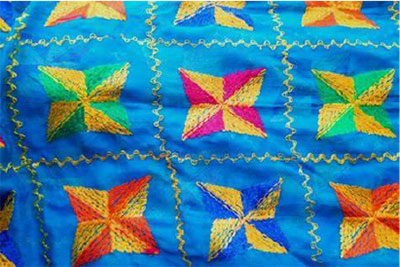
Phulkari is a hereditary embroidery tradition. It is a form of thread embroidery recognised by its neat, regular patterns of geometric and natural motifs. Phulkari word translates to ‘flower work’ in Hindi and Punjabi. Phulkari garments came to be closely associated with major events in their lives, particularly marriage. There are various types of Phulkaris like the Chope which is made with a reversible, double darning stitch and holds the most ritualistic importance as it is embroidered by bride’s grandmother, who presents it as a wedding gift to be worn by the bride during the marriage ceremony. Others include the Sainchi phulkari from the Bathinda and Faridkot districts. Nilak phulkari is embroidered in red and yellow over blue cotton-based cloth, Thirma phulkari is made on a white base, the Shishedar phulkari is made with glass pieces, Til patra phulkari is made with patterns of sesame seed motifs while Suber phulkari is embroidered only in the corners. Today phulkari is produced in various district of Chandigarh and applied to several types of Indian garments, particularly dupattas, kurtas, blouses and sarees using various cotton fabrics as a base.
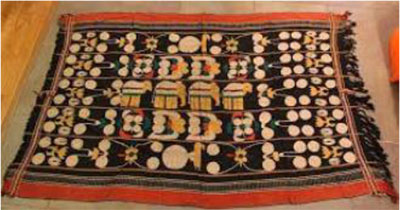
Dhurrie is a type of Indian Carpet which is produced by the process of weaving. Dhurries are made physically by gifted weavers and sometimes produced by using vertical weaving Machine. They are made using cotton, fleece, jute and silk. The raw material is first converted into strings and then woven into durries. There are mainly three kinds of dhurries called Navalgund Jamkhana, Ja-Namaz and Guddar. Dhurries generally have geometric and floral pattern. The idea of dhurries is different from the carpets and rugs as dhurries are used for bedding beside spreading on the floor. Famous market to buy Dhurries in Chandigarh is Shastri market.
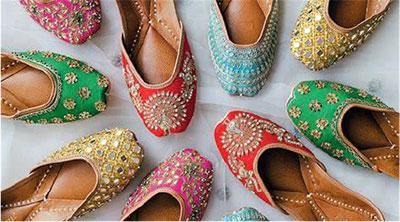
Juttis are popular traditional footwear in Chandigarh. “Jutti” is an Urdu word for a shoe with a closed upper attached to a sole. Juttis come in many variations according to regional traditions and shoemaker. They are also adapted according to the environment and materials. One of the unique characteristics of this kind of footwear is that they have no left and right distinction and they are manually embroided using wire of gold or silver called Tilla. This wire is embroidered all over, covering the entire surface of the pair. Men handle the cutting, shaping and assembling of the shoe while women help with the work of beautiful embroideries on the top, back and sometimes even inside of the Jutti.
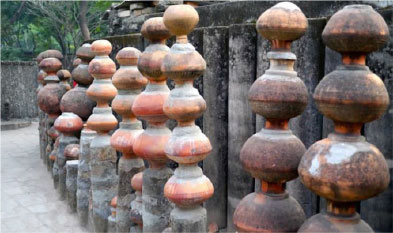
In Chandigarh and the neighbouring areas, pottery is a craft with a strong cultural and traditional foundation. Chandigarh, being a relatively new city compared to other historic Indian cities, is influenced by states such as Punjab, Haryana, and Himachal Pradesh. Various forms of pottery are practiced in these regions these include Terracotta pottery, a centuries-old tradition, features natural motifs, geometric patterns, and intricate carvings consisting of pots, vases, lamps, and decorative figurines. Blue pottery, originating from Jaipur also found in Chandigarh, is made from a unique mixture of quartz and glass. Its vibrant blue and white patterns depict floral and animal motifs. Glazed pottery, a technique that applies a glassy coating, is waterproof and durable. Pottery is a cultural and artistic expression of the region and a sustainable heritage craft utilising natural materials and traditional firing methods.
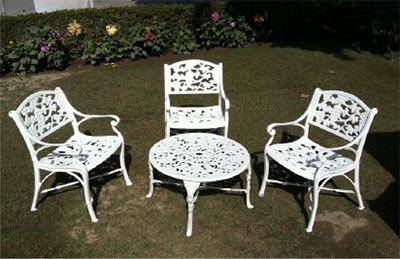
Chandigarh being a city developed by the architectural skills of the Swiss-French architect Le Corbusier, masters in the skill of producing wrought iron furniture. During the post-independence era, Chandigarh developed as a symbol of modernity and progress in India. Wrought iron furniture became popular during this period, aligning with the city’s contemporary design ethos. Wrought iron furniture is renowned for its strength and durability, making it suitable for both indoor and outdoor use. Its timeless appeal and intricate designs complement the modernist architecture of Chandigarh, adding elegance to homes and public spaces.

Cane furniture production in Chandigarh is significant due to its integration of traditional craftsmanship into the city’s modernist design ethos. The lightweight, eco-friendly and flexible nature of cane furniture has gained popularity since the 1950s, promoting sustainable living and supporting local artisans. Artisans skilled in cane work have found a place in the city's markets, contributing to the local economy and maintaining cultural heritage. The natural aesthetics of cane furniture complement the modernist architecture and green spaces, making it a preferred choice for both indoor and outdoor settings. Recently, there has been a renewed interest in sustainable and eco-friendly materials, further boosting the significance of cane furniture. This trend supports environmental sustainability and the livelihoods of local craftsmen, ensuring the passing down of traditional skills.
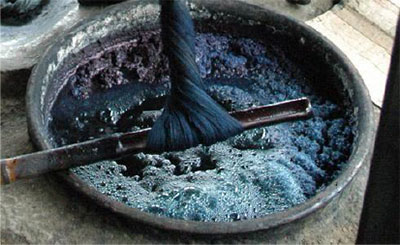
Chandigarh's turban and veil dyeing is a significant cultural tradition, reflecting skilled craftsmanship and traditional attire in northern India. Various dyeing techniques are incorporated by the dyers in Chandigarh these include Tie and Dye (Bandhani) which involves tying the fabric in intricate patterns before dyeing and creating beautiful designs. Leheriya, A technique creating wave-like patterns on fabric, commonly used for turbans and veils; Block Printing and Hand Painting which is used to add intricate designs and motifs to the fabric after dyeing. Dyers in Chandigarh are skilled artisans who often inherit their craft through generations. They use natural and synthetic dyes to achieve vibrant colour and intricate patterns on turbans and veils.

Cane furniture production in Chandigarh is significant due to its integration of traditional craftsmanship into the city’s modernist design ethos. The lightweight, eco-friendly and flexible nature of cane furniture has gained popularity since the 1950s, promoting sustainable living and supporting local artisans. Artisans skilled in cane work have found a place in the city's markets, contributing to the local economy and maintaining cultural heritage. The natural aesthetics of cane furniture complement the modernist architecture and green spaces, making it a preferred choice for both indoor and outdoor settings. Recently, there has been a renewed interest in sustainable and eco-friendly materials, further boosting the significance of cane furniture. This trend supports environmental sustainability and the livelihoods of local craftsmen, ensuring the passing down of traditional skills.

Chandigarh's turban and veil dyeing is a significant cultural tradition, reflecting skilled craftsmanship and traditional attire in northern India. Various dyeing techniques are incorporated by the dyers in Chandigarh these include Tie and Dye (Bandhani) which involves tying the fabric in intricate patterns before dyeing and creating beautiful designs. Leheriya, A technique creating wave-like patterns on fabric, commonly used for turbans and veils; Block Printing and Hand Painting which is used to add intricate designs and motifs to the fabric after dyeing. Dyers in Chandigarh are skilled artisans who often inherit their craft through generations. They use natural and synthetic dyes to achieve vibrant colour and intricate patterns on turbans and veils.
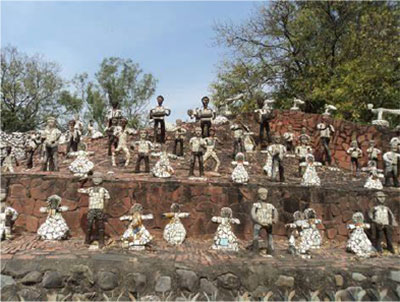
Rock crafts in Chandigarh hold a unique place in the city’s artistic and cultural landscape, blending traditional craftsmanship with modern design principles. The most iconic example of rock craft in Chandigarh is the Rock Garden created by Nek Chand, a self-taught artist and government official. The rock craft is made up of local stones, pebbles, and rocks. Sculpting and carving are the primary techniques used which is often combined with mosaic (Assembling stones together) to create intricate designs. The art form involves both traditional hand tools and modern techniques to shape and polish the rocks. The designs often reflect natural forms like animals, birds, and human figures and geometric patterns are also common reflecting the modernist influence. The rock crafts have become a symbol of Chandigarh’s cultural heritage and artistic innovation. They represent a blend of traditional Indian craftsmanship and modern design unique to Chandigarh.